LFH Overview
Books from the Series
Career Turbulence
Entrepreneurship and Ethics in Ancient Rome
Project Impossible
Project Management Blunders
Titanic Lessons in Leadership
The History of Project Management
Polaris Lessons in Risk Management
Churchill the Agile Project Manager
Project Lessons from the Roman Empire
Project Lessons from the Great Escape
Churchills Adaptive Enterprise
Avoiding Project Disaster
Career Turbulence: Ancient Lessons for Survival in the Modern Workplace
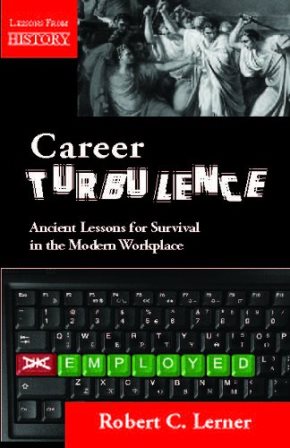 |
In the United States during 2010, as a direct result of the global economic turbulence of 2008 and 2009, there were over 1 million company failures, unemployment spiked to 10%, and housing foreclosures financially crippled a staggering 3.8 million homeowners. The terrible impact of that financial crisis still to this day reverberates through the global economy and U.S. unemployment remains at painfully elevated levels. Economists called this event a recession. However, to paraphrase an old saying, if you are one of those left unemployed, it is not a recession, it’s a depression. Since most of our personal financial wellbeing is dependent on our employment, the loss of a job can result in the complete destruction of our personal wealth. Job preservation then is key to financial stability, but during periods of long-lasting turbulence, survival in the workplace requires a radically different approach than in normal times. In dangerous economic times self-interest must emerge as a critical component of your job survival strategy.
|
Entrepreneurship and Ethics in Ancient Rome
 |
Nearly 2000 years ago a wealthy Roman Senator, Pliny the Younger, wrestled with the effects of collapsing grape prices on his Tuscan vineyard. Pliny, very much the Roman traditionalist, was in fact an innovative businessman whose problem analysis and ethical approach to his decisions, all made without the support of the modern technology taken for granted today, translates exceptionally well into the modern business world. Pliny’s actions during that business crisis are evaluated from the perspective of a modern day CEO and provide critical guidance for today’s entrepreneurs and students of business. This study, primarily drawn from Pliny’s collection of letters, provides the foundation upon which a modern business framework of 20 lessons is constructed. These management lessons discuss topics such as personal leadership, business ethics, risk management, financial management as well as innovation and are augmented with commentary drawn from the author’s experience in managing and leading global businesses over a 30-year career. The book intentionally eschews modern case studies and instead exclusively utilizes ancient examples that include not just those of Pliny, but also other elites of Roman society (e.g. Emperors Augustus, Tiberius, Vespasian and Trajan, Triumvirs Julius Caesar and Marcus Crassus, and Pliny’s hero Cicero) as well as members of the lower classes (e.g. the freedman Eurysaces who’s puzzling tomb is still extant in Rome, the garum king of Pompeii and Zacchaeus, a Roman tax collector discussed at length in the New Testament). This text and its lessons successfully bridge the two millennia separating the business world of ancient Rome from ours, allowing a new generation of entrepreneurs and business managers to benefit from Pliny’s counsel, entrepreneurial outlook and progressive style of business management.
|
Doing the Impossible
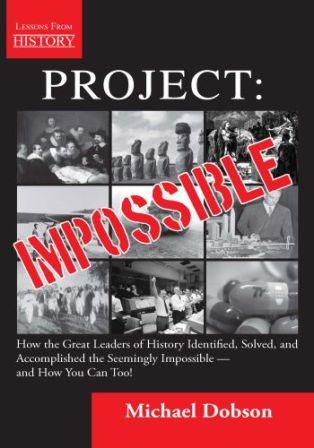 |
How the great leaders of history identified, solved, and accomplished impossible projects (and how a few of them didn’t). If a project is in fact impossible, it’s not going to be accomplished, but many projects thought to be impossible are accomplished every day. There are many different types of impossibility: legal impossibility, scientific impossibility, metaphysical impossibility, and logical impossibility, to name a few. Each has its own definition and its own specific context. Our question is more focused: what does “impossible” mean in a business context — and more importantly, what does it mean in the context of your project? What the projects in this book all have in common is that they appeared impossible (or at the very least highly problematic) to a reasonable observer in advance. Of course, from our contemporary perspective, we already know the outcome, but that shouldn’t blind us to the magnitude of the original challenge. There’s an unfortunate tendency to pooh-pooh an accomplishment based on twenty-twenty hindsight. But as in all of our Business Lessons from History, it’s vital not to forget how it looked to the original project manager at the beginning of the project. The vision, the creativity, the hard work, and the courage necessary to face and overcome overwhelming, titanic challenges should never be trivialized or overlooked.
|
Project Management Blunders - Titanic Lessons from the Project that Built, Launched and Sank Titanic (New Edition)
 |
In the centenary year (1912-2012) this third edition continues the evolution of Titanic books in the series, and reviews the case study from entirely a project management perspective. Based on the latest research, brought forward by the Titanic community, it carefully examines all the phases of the project (initiation, planning, design, construction, testing, implementation & operations) using the modern lens of the Project Management Body of Knowledge. In particular, the 10 month period from Olympic's maiden voyage through to her collision with HMS Hawke, and the substantial impact on the project completing Titanic. The Titanic case study covers all aspects of inadequate project management that can lead to project failures (or disasters) to name a few, meddling stakeholders, different agendas, compromises, a rushed job, more compromises, changes late in the project, improper testing, and a poor implementation. This is where the biggest learning lessons are for projects today.
|
Titanic Lessons in Project Leadership
 |
In this new addition to the ‘Lessons from History’ series, Ranjit Sidhu shows how ‘small’ and easily overlooked behavioural and communication issues can build into big mistakes if they are not recognised and managed. As the story unfolds, Ranjit explains why it is critical that project managers and leaders have the skills to deal effectively with people issues, and shows what we can learn to make our projects and programmes more successful today. She suggests that project managers need to be just as comfortable managing conflict and motivating teams as planning work and conducting a risk analysis. Acknowledging the tendency, when faced with challenging deadlines and daily pressures, to focus on just getting the task done, Ranjit stresses the dangers of this approach. The difficult conversations with upset stakeholders and disgruntled customers can’t be sidestepped and leaders need to gain the skills to approach these with confidence. Ranjit draws on the people aspects of the tragic Titanic story to describe the ‘behind the scenes’ aspects of human communication and leadership, highlighting the practices that can make a vital difference to the success of projects. Combining contemporary management theory with her own insights and extensive project management experience, she offers practical guidance and a deeper understanding of how leaders and teams can operate at their very best.
|
The History of Project Management
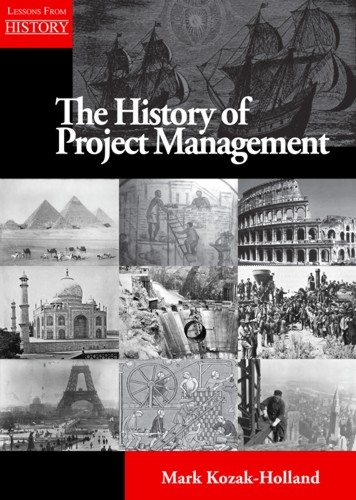 |
The book addresses the origins of project management and the general perception that it was initiated and evolved in the 20th century. Yet how were all the great projects of the past delivered, like the Giza Pyramid, the Parthenon, the Colosseum, the Gothic Cathedrals of Europe, and the Taj Mahal. Was project management used? Were the concepts of project management understood? This ambitious book presents the case that the discipline of project management did not just appear in the last 100 years but has been part of a steady evolution for at least 4,500 years.
|
Polaris: Lessons in Risk Management
 |
The Polaris project was conceived and designed in the 1950s. It was vital to the security of the Western world during the Cold War. It created a weapon system designed to launch nuclear ballistic missiles from submerged submarines that could remain undetectable until called upon to complete their mission. This project is often compared to America’s Apollo space program due to its significant engineering accomplishments. But it is just as vital to modern risk management as it is to international security. The project was an endeavor that many considered impossible. To many, engineering and technology had not progressed far enough at the time to allow such a weapon to be created. The project team realized that to make the impossible possible would require proper risk management which was key to success. The project developed many of today’s risk management techniques. The book is designed to make risk management easier and less time consuming to perform. Thus, allowing organizations to improve their performance in this critical area. This book covers methods listed in the Project Management Book of Knowledge (PMBOK) Guide® and many newer methods not listed. In this manner, risk management is explained and simplified so that every project manager can employ this critical area to improve project performance!
|
Agile Leadership & Management of Change - Winston Churchill
 |
Winston Churchill is widely regarded as one of the greatest leaders of the 20th century. But as he became Prime Minister in May 1940, in a period of calamitous change during World War II, what did he actually do? How did he transform his organization to turn his perilous situation around? Both Churchill in 1940 and business people today grapple with an unprecedented level of change adversely impacting their organizations at the enterprise, business unit, or project level. This book analyzes a period of time from WW II when Winston Churchill faced near defeat for the British in the face of sustained German attacks. The book describes the strategies he took to overcome incredible odds and turn the tide on the impending invasion. Aimed at business executives, IT managers, and project managers, the book extracts learnings from Churchill's experiences that can be applied to business problems today.
|
Project Lessons from the Roman Empire
 |
The leaders of the Roman Empire established many of the organizational governance practices that we follow today, in addition to remarkable feats of engineering using primitive tools that produced roads and bridges which are still being used today, complex irrigation systems, and even "flush toilets." Yet, the leaders were challenged with political intrigue, rebelling team members, and pressure from the competition. How could they achieve such long-lasting greatness in the face of these challenges? In this new addition to the Lessons from History series, join author Jerry Manas as he takes you on a journey through history to learn about project management the Roman way. Discover the 23 key lessons that can be learned from the successes and failures of the Roman leadership, with specific advice on how they can be applied to today's projects. Looking at today's hottest topics, from the importance of strategic alignment for your projects through to managing transformational change and fostering work/life balance while still maintaining overall performance, you'll find that the Romans already faced-and conquered-these challenges 2000 years ago. |
Project Lessons from the Great Escape (Stalag Luft III)
 |
While you might think your project plan is perfect, would you bet your life on it? In the Second World War, a group of 220 captured airmen did just that -- they staked the lives of everyone in the camp on the success of a project to secretly build a series of tunnels out of a prison camp their captors thought was escape proof. The prisoners formally structured their work as a project, using the project organization techniques of the day. This book is about how the escape committee, under tremendous pressure, inspired their inmates around them to continue a fight considered lost. Not only did they have to stave off hunger, psychological pressures but deliver a project under acute circumstances. This meant understanding the problems facing them, focusing slender resources on the immediate task in hand, unifying the camp prisoners, and directing these into the project. With very little time the escape committee transformed the camp into an agile project one that could adapt to changing and unexpected daily situations.
|
Churchill's Adaptive Enterprise: Lessons for Business Today
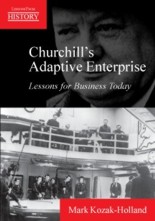 |
The Adaptive Enterprise is a modern concept, or is it? This book explores how Churchill and his Cabinets' actions, under tremendous pressure in May 1940, transformed their organization to the modern-day version of an Adaptive Enterprise. By definition an Adaptive Enterprise modifies organizational behaviour, how it addresses and responds to change, to give it a competitive edge. With no room for error, the use of organizational adaptation, business practices and current technology, combined with the inspiration of the leaders, gave the United Kingdom the opportunity to halt a sequence of disasters and provide a means to start to turn the tide around. Through the practices, technologies, and organization that Churchill established, saw the emergence of governance and decision-making concepts well before they are widely believed to have been invented and used. Aimed at IT managers, and project managers, the historical analysis is done through a modern business and information technology lens, describing Churchill's actions and strategy.
|
Avoiding Project Disaster: Titanic Lessons for IT Executives
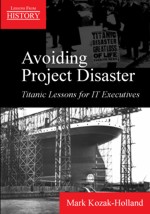 |
Imagine you are in one of Titanic's lifeboats, drifting away from the sinking ship. As you look back, you wonder how such a disaster could have happened. Titanic's maiden voyage was a disaster waiting to happen as a result of the compromises made during its construction project. This book explores how IT Executives & IT Project Managers can take lessons from this nuts-and-bolts construction project and apply them to their IT projects today. This book shows how the lessons learned from the disaster can be applied to IT projects today. In modern IT projects, we often have situations where we believe that we have designed, built, or launched a "perfect" solution. This book juxtaposes the Titanic story and modern IT projects so that we can learn from the disaster and avoid making similar mistakes.
|

